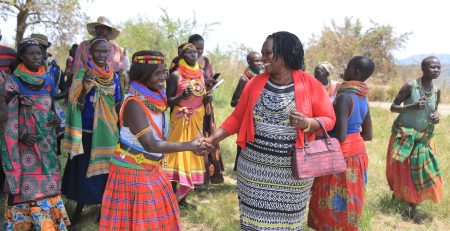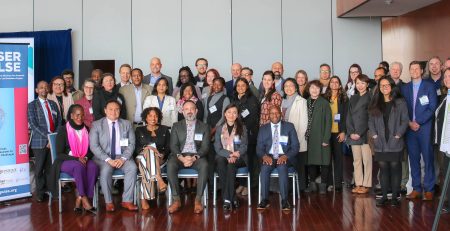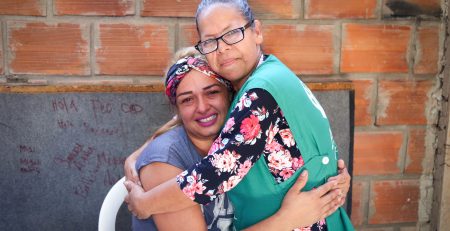Data-Driven Decision Support for Improved Water Security in East Africa
Margaret W. Gitau, Victoria M. Garibay, Nicholas S. Kiggundu, James S. Kisekka, Victor Kongo, Bancy M. Mati, Daniel N. Moriasi, and Subira E. Munishi

Wait! Yes, you. Stop for one moment and work with us on this one. Imagine a world without fresh water. Now imagine a world without clean fresh water; regardless of whether it is in plenty or scarce, it is all polluted. It’s green and turbid, or with floating debris and other solid waste, maybe even smelling. And keep in mind, not all pollutants lead to visible pollution. Then look at the shore, see the dead fish, even they could not stand it any longer. Older members of society might reflect on how they used to play in the river or swim in the lake when they were little children. Now a walk along any of these could even be repulsive. Children might be warned to stay away from the water because they could get sick. Sure, the water can be treated (we know you are thinking it) but did you know that treatment processes may not always remove all pollutants in water? Of course, if there isn’t any water to start with, the issue of quality becomes a moot point. What about when there are floods? Floods carry massive loads of pollutants, damage infrastructure, displace peoples, and cause other types of damage. Kampala, Uganda, for example, suffers $49.6 million in annual average damage to buildings with the number of people frequently affected by floods exceeding 170,000, according to 2021 estimates by the World Bank.

“What is the status of water quality in your area?” we asked our stakeholders. Though the question was fairly simple, responses varied substantially. To know for sure, we need data. And the same goes for water availability. In the East African countries Kenya, Tanzania, and Uganda, surface and ground water availability vary substantially with time and climate, and across subregions. Climate, land use, and land management changes are key factors affecting the integrity of water resources (both quantity and quality) in the three countries, yet related data are generally insufficient, unavailable, or inaccessible for effective water resources decision-making and management. In this project, we set out to provide water information, data access, and decision support to improve water resources (quantity and quality) management and, ultimately, water security in East Africa.

The culminating point of our water security project was a two-day workshop held in September 2022 in Dar es Salaam, Tanzania. Of the three modules we offered during the workshop (Modeling, Research/Results Translation, Data Policy) the module on Data Policy generated the most interest and in-depth discussions. Key issues that emerged were data availability and accessibility. In some cases, the data simply did not exist. Even where data were available, accessibility remained an issue, sometimes requiring substantial payment to access the data or involving bureaucracies that present enormous frustrations to researchers and practitioners looking to access and use the data. Other times, accessibility issues were attributable to mistrust between data custodians—typically government agencies—and researchers, and the lack of understanding on the custodians’ part as to the benefits of allowing the data to be used in research and decision-making applications. There were also concerns about national security, particularly where transboundary waters are concerned. The question was raised as to how the data situation in each country could be improved.
The importance of learning from developed countries in which data are available and accessible and used effectively for development was underscored. Overall, the commitment by the respective governments to make data available and accessible for free, at least to researchers, and to dedicate funding allocations for (water and climate) data collection and curation emerged as key ways in which the situation in each country could be improved. The potential for misuse of data in transboundary conflict was acknowledged by all parties and the registration and screening of data requesters was proposed as a solution.

Whichever way we look at it, our best bet for water security lies in managing and protecting our waters in the environment—our lakes, rivers, streams, reservoirs/dams, wetlands, groundwater—both from the perspective of quantity and quality. And the way to do this is by managing contributing landscapes better, which is a long shot without data, information, and tools. Through this project, we provided the water information, data, and training needed to improve water resources decision-making and management and, ultimately, water security in East Africa. We built local capacity through training for water resources managers and related personnel, policy makers, and youth, allowing our methods and tools to be applicable in other locations beyond the pilot study locations and adaptable to the African continent and beyond.

Scan the QR code or click here to access our products!
This blog is made possible by the support of the United States Agency for International Development (USAID) via the Long-Term Assistance and SErvices for Research Partners for University-Led Solutions Engine (LASER PULSE) program. The contents herein are those of the authors and do not necessarily reflect the views of USAID, LASER PULSE or the United States Government.







Leave a Reply
You must be logged in to post a comment.